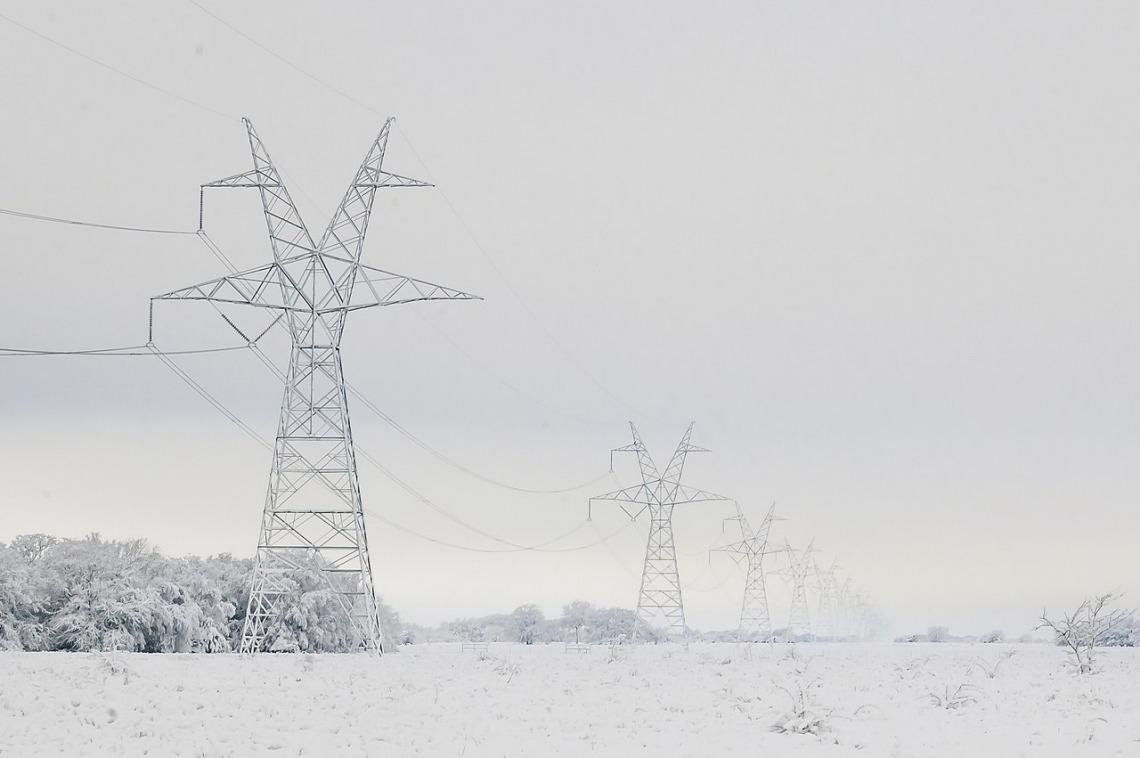There is a conveyor belt of water that runs throughout Earth's oceans. Its churning is driven by variances in the temperature and saltiness of the water, and weather patterns across the globe are controlled by its activity.
 Transmission towers and lines were covered in snow in East Texas. The state experienced a power crisis during severe winter storms in February, resulting in about $20 billion in socioeconomic damages, according to NOAA. Image Credit: Matthew Rader
Transmission towers and lines were covered in snow in East Texas. The state experienced a power crisis during severe winter storms in February, resulting in about $20 billion in socioeconomic damages, according to NOAA. Image Credit: Matthew Rader
Two scientists examined the Atlantic portion of this global conveyor belt known as the Atlantic Meridional Overturning Circulation (AMOC) and discovered that winter weather in the United States critically relies on this conveyor belt-like system. As the AMOC decelerates due to climate change, the United States will undergo more extreme cold winter weather.
The study, reported in the Communications Earth & Environment journal was headed by Jianjun Yin, an associate professor in the University of Arizona’s Department of Geosciences, and co-authored by Ming Zhao, a physical scientist at the National Oceanic and Atmospheric Administration's Geophysical Fluid Dynamics Laboratory.
AMOC functions like this: Warm water moves north in the upper Atlantic Ocean and emits heat into the atmosphere at high latitudes. When the water cools, it turns thicker, which causes it to sink into the deep ocean where it travels back south.
This circulation transports an enormous amount of heat northward in the ocean. The magnitude is on the order of 1 petawatts, or 10 to the 15 power watts. Right now, the energy consumption by the entire world is about 20 terawatts, or 10 to the 12 power watts. So, 1 petawatt is enough to run about 50 civilizations.
Jianjun Yin, Study Lead and Associate Professor, Department of Geosciences, University of Arizona
But when the climate warms, so does the surface of the ocean. Simultaneously, the Greenland ice sheet experiences melting, causing huge quantities of fresh water to be dumped into the ocean. Both warming and freshening of the water can decrease surface water density and hinder the sinking of the water, decelerating the AMOC. If the AMOC decelerates, so does the northward heat movement.
This is significant because, compared to the poles, the equator receives more energy from the sun. Both the ocean and atmosphere work to convey energy from low latitudes to high latitudes. If the ocean is unable to convey as much heat northward, then the atmosphere must instead convey more heat via more extreme weather systems at mid-latitudes.
When the atmosphere transports heat northward, cold air is moved from the poles and driven to lower latitudes, reaching regions as far south as the U.S. southern border.
Think of it as two highways connecting two big cities. If one is shut down, the other one gets more traffic. In the atmosphere, the traffic is the daily weather. So, if the ocean heat transport slows or shuts down, the weather becomes more extreme.
Jianjun Yin, Study Lead and Associate Professor, Department of Geosciences, University of Arizona
Yin said the research was driven by the extreme cold weather that Texas endured in February.
In Houston, the daily temperature dropped to 40 degrees Fahrenheit below the normal. That's the typical range of a summer/winter temperature difference. It made Texas feel like the Arctic. This kind of extreme winter weather happened several times in the U.S. during recent years, so the scientific community has been working to understand the mechanism behind these extreme events.
Jianjun Yin, Study Lead and Associate Professor, Department of Geosciences, University of Arizona
The crisis in Texas caused extensive and disastrous power outages, and the National Oceanic and Atmospheric Administration estimated that socioeconomic damages equaled $20 billion. Yin was inquisitive about the role played by the ocean in extreme weather events.
Yin and Zhao used an advanced, high-resolution global climate model to quantify the impact of the AMOC on extreme cold weather in the United States.
They worked the model two times, first exploring the current climate with a functioning AMOC. They then modified the model by inputting sufficient freshwater into the high-latitude North Atlantic to prevent the AMOC. The difference exposed the role of the AMOC in extreme cold weather. They learned that without the AMOC and its northward heat movement, very cold winter weather builds up in the United States.
According to the latest observational studies, the AMOC has been declining in the last few decades. Climate models estimate it will become even weaker in reaction to higher levels of greenhouse gases in the atmosphere.
But there is uncertainty about the magnitude of the weakening because, at this point, we don't know exactly how much the Greenland ice sheet will melt. How much it melts depends on the greenhouse gas emissions.
Jianjun Yin, Study Lead and Associate Professor, Department of Geosciences, University of Arizona
The scientists also did not consider the effects of human-caused global warming in their model, but that is an area that would be looked into in the future, Yin said.
"We basically just turn off the AMOC (in the model) to look at the response by extreme weather," he said. "Next, we want to factor in the greenhouse gases and look at the combined effects of the AMOC slowdown and global warming on extreme cold weather."
Journal Reference:
Yin, J., & Zhao, M. (2021) Influence of the Atlantic meridional overturning circulation on the U.S. extreme cold weather. Communications Earth & Environment. doi.org/ 10.1038/s43247-021-00290-9